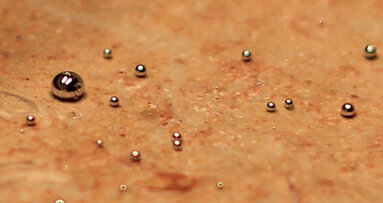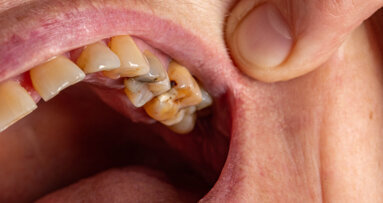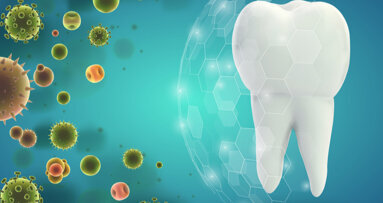TOKYO, Japan: Dental caries is a major health problem affecting the quality of life of many people worldwide. Products released by bacteria on the surface of teeth are known to be one of its major causes, but there has been difficulty in diagnosing the disease at an early stage. Recently, researchers at Tokyo Medical and Dental University (TMDU) have developed a microsensor that can determine the pH on tooth surfaces with high accuracy. The pH level is used to distinguish between active and arrested caries.
The sensor is based on iridium oxide and has a diameter of only 300 μm. This means that the device can be used to analyse small specific patches of tooth surfaces where localised caries may have become established. The small dimensions of the sensor allow its use to analyse cavities or closely opposing surfaces of teeth, sites where conventional visual examinations cannot be performed.
By making use of this method, there is no need for subjective judgements by dentists or subjecting patients to investigative methods involving X-rays or other harmful procedures. In addition, the device provides accurate and quantitative findings on the vulnerability of caries, according to the TMDU researchers.
The team also found that the results obtained with the new sensor matched well with the findings of visual inspection by a dentist, suggesting that this approach is robust and reliable. It can avoid any subjectivity associated with conventional visual analysis by providing an objective, quantitative screening tool, the researchers said.
Senior author Prof. Yuji Miyahara at TMDU’s Institute of Biomaterials and Bioengineering said, “After creating this sensor and testing its accuracy on standard pH solutions, we analysed it using 18 extracted human teeth with different levels of caries. It could identify significant differences in pH levels among sites known to have active caries, sites with arrested caries, and healthy unaffected roots.”
Co-author Dr Miyuki Tabata, assistant professor at the institute, added that this new tool should help dentists identify caries at an earlier stage in order to provide “better and less invasive treatments”. She concluded: “It also helps us to distinguish between cases of active caries and cases of arrested caries in which remineralisation has started to occur, for which different treatments would be applied.”
The study, titled “PH mapping on tooth surfaces for quantitative caries diagnosis using micro Ir/IrOx pH sensor”, was published in April 2018 in Analytical Chemistry.
Tags:
TOKYO, Japan: Extensive research shows that Porphyromonas gingivalis is linked with the initiation and progression of periodontal disease. The antimicrobial...
NEWBERG, Ore., U.S.: Dental equipment manufacturer A-dec has announced that it has begun manufacturing personal protective equipment (PPE) in response to ...
LEIPZIG, Germany: Rural communities across the US are facing a growing oral health crisis as access to fluoridated water and dental care diminishes. This ...
GENEVA, Switzerland: The first meeting of the Conference of the Parties (COP) to the Minamata Convention on Mercury was held at the end of September at the ...
SAN DIMAS, Calif., US: In a fresh overview on a hot topic, researchers with Stevenson Dental Research Institute in California have released a curated guide ...
HEFEI/HONG KONG, China: Numerous methods have been investigated to manage dental caries, which is, along with other oral diseases, the most widespread ...
EDINBURGH, UK: The chief executive of the UK’s Oral Health Foundation (OHF) told the media in November that HIV could be transmitted through the sharing ...
LONDON, UK: A new report, published last week by the Alliance for a Cavity-Free Future (ACFF) and the Policy Institute at King’s College London in the UK,...
LONDON, UK: Though the relative benefits of chewing gum are often subject to debate, a number of studies have shown that the sugar-free varieties can ...
ZWOLLE, Netherlands: Renate Vries has been a dental hygienist for over 20 years. Currently, she works at Tandartspraktijk Linde, a small clinic located in ...
Live webinar
Mon. 22 December 2025
1:00 pm EST (New York)
Live webinar
Mon. 12 January 2026
9:00 am EST (New York)
Prof. Judith Jones D.D.S; M.P.H., Prof. Kakuhiro Fukai D.D.S., Ph.D, Dr. Bathsheba (Bethy) Turton
Live webinar
Wed. 14 January 2026
12:00 pm EST (New York)
Dr. Théo Laplane, Dr. Robert Gottlander DDS
Live webinar
Fri. 16 January 2026
12:00 pm EST (New York)
Live webinar
Mon. 19 January 2026
1:00 pm EST (New York)
Philipp Kopp, Michael Seeber
Live webinar
Thu. 22 January 2026
2:00 pm EST (New York)
Dr. Nicola M. Grande DDS, PhD
Live webinar
Wed. 28 January 2026
8:00 am EST (New York)



 Austria / Österreich
Austria / Österreich
 Bosnia and Herzegovina / Босна и Херцеговина
Bosnia and Herzegovina / Босна и Херцеговина
 Bulgaria / България
Bulgaria / България
 Croatia / Hrvatska
Croatia / Hrvatska
 Czech Republic & Slovakia / Česká republika & Slovensko
Czech Republic & Slovakia / Česká republika & Slovensko
 France / France
France / France
 Germany / Deutschland
Germany / Deutschland
 Greece / ΕΛΛΑΔΑ
Greece / ΕΛΛΑΔΑ
 Hungary / Hungary
Hungary / Hungary
 Italy / Italia
Italy / Italia
 Netherlands / Nederland
Netherlands / Nederland
 Nordic / Nordic
Nordic / Nordic
 Poland / Polska
Poland / Polska
 Portugal / Portugal
Portugal / Portugal
 Romania & Moldova / România & Moldova
Romania & Moldova / România & Moldova
 Slovenia / Slovenija
Slovenia / Slovenija
 Serbia & Montenegro / Србија и Црна Гора
Serbia & Montenegro / Србија и Црна Гора
 Spain / España
Spain / España
 Switzerland / Schweiz
Switzerland / Schweiz
 Turkey / Türkiye
Turkey / Türkiye
 UK & Ireland / UK & Ireland
UK & Ireland / UK & Ireland
 Brazil / Brasil
Brazil / Brasil
 Canada / Canada
Canada / Canada
 Latin America / Latinoamérica
Latin America / Latinoamérica
 USA / USA
USA / USA
 China / 中国
China / 中国
 India / भारत गणराज्य
India / भारत गणराज्य
 Pakistan / Pākistān
Pakistan / Pākistān
 Vietnam / Việt Nam
Vietnam / Việt Nam
 ASEAN / ASEAN
ASEAN / ASEAN
 Israel / מְדִינַת יִשְׂרָאֵל
Israel / מְדִינַת יִשְׂרָאֵל
 Algeria, Morocco & Tunisia / الجزائر والمغرب وتونس
Algeria, Morocco & Tunisia / الجزائر والمغرب وتونس
 Middle East / Middle East
Middle East / Middle East















































To post a reply please login or register